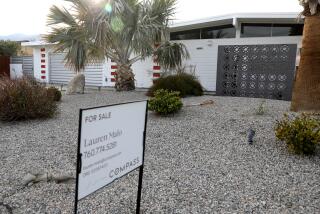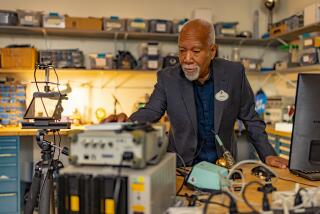House Hunting Is Going High-Tech
- Share via
Glenn Hightower would like to build a robot that sells for $10,000 and cleans baths, but for the moment, the 32-year-old inventor is marketing a high-tech system he created for people looking to buy and sell homes.
The system--consisting of a laser disk, a personal computer, a monitor and two printers--allows a shopper to view color pictures of a home and get such particulars as the number of bedrooms and baths, square footage, type of architecture, lot size, and year built, along with comments such as:
--”Previous owner was a horticulture enthusiast who landscaped spacious yard;
--”Large tangerine tree yields tasty fruit, and
--”A cheery Spanish-style kitchen to please family cooks.”
Before any of this appears on the computer screen, the home is qualified by price and other requirements.
Using Split Screen
“Say a person wants a four-bedroom house in Glendora for $375,000 to $500,000,” Hightower suggested. “Then we just type in these requirements, they appear on the right side of the (split) screen, we push a button, and a list of homes in this category appears on the left side.”
Suppose the shopper is only interested in four-bedroom Glendora houses with swimming pools in this price range. Another button is pushed and a list of these houses appears.
The data is not unlike that on multiple listing sheets, and computerization is no newcomer to many real estate offices. So what’s new and different about Hightower’s system?
“Basically, two things,” he answers. “First, the terminal goes fast, much faster than the low-capitalized operations of most real estate offices.
“And second, there is video.”
Color Photos
Not only can the laser disk of Hightower’s system store 5,000 listings, he said, but it can also contain eight to 20 color photos of each home, whereas multiple listing sheets usually only have a couple of photos at most, and those are in black and white. Hightower’s system can hold an estimated 55,000 stills.
“So not only can you read some text about what the house has but you can see the living room, the fireplace and the built-in bookcase,” he noted. “You can see the mountain view.”
The number of pictures per home depends on the list price. As Hightower put it, “Ten pictures is about right for a $120,000 house, and maybe 20 pictures for a $1-million home.”
The home shopper can get printouts of the pictures and the text.
Pictures can also be useful as a sales tool for walk-in traffic, Hightower said, “because a real estate agent could put, say, 341 properties on the (laser) disk, put the disk on a roll, and then go (automatically) from one property to another on video.” By putting the monitor in the office window, the broker might entice passers-by to ask about pictured homes.
Used in Valleys
This is happening already in the San Gabriel and San Fernando valleys, where his invention, known as Video Listing Systems, is in use. Many companies, including such major organizations as AT&T;, have tried to develop laser disk, video listing systems, Hightower says, but he claims that his firm is “the only manufacturer to have a system working in realty offices.” His system is currently operating in 25.
“I want to penetrate all of Southern California,” he said, “but we started in the San Gabriel Valley because our offices are located there. We’re in Pasadena.”
So is APh Technological Consulting, which he founded 11 years ago. VLS is an adjunct.
“APh is our research-and-development firm,” he explained. It has designed computer applications for time clocks that don’t need time cards, created sophisticated electronic cash registers, designed an apple sorter and worked on motion picture special effects.
“VLS was formed in 1984 in anticipation of (marketing) the video listing product,” he added. The product was developed after Hightower went apartment hunting and “hit upon this idea of combining laser technology with a much-needed service,” as he phrases it.
In Space Program
VLS contracts for maintenance with APh, which has 42 employees--”most of them engineers who graduated from Caltech,” he said.
Hightower is a Caltech graduate with a master’s degree in applied physics. As early as his sophomore year, he was involved in the U.S. space program, writing computer programs to reduce spacecraft data.
He has been called an electronics wizard for his inventiveness. Not only did he create APh and VLS and still heads both firms, but he contends that he was the originator of the first hand-held video games. He says he instructed Mattel engineers in microprocessing.
No wonder then that the idea of a game came to mind as a way to sell VLS to attendees of the California Assn. of Realtors convention last week in Anaheim.
Anyone who visited the VLS display could become eligible to play on a giant Monopoly board for prizes including sets of Monopoly. The promotion was also appropriate because it coincided with the game’s 50th anniversary year.
Invented Table
To become eligible to play, attendees had to sit through a VLS demonstration, which took a few minutes and allowed questions like cost to be answered.
Cost varies, depending on what is needed, but Hightower said that equipment rental could run as low as $265 a month, “and that would include a first-year subscription to disk software.”
His company also invented a table on wheels for the equipment, and that sells for $300 to $400, depending on size and features.
Since January, when his system was installed in a realty office for the first time, his firm made a few discoveries. Among them: “We found out that we had to be in the furniture business.” This was during what he describes as “the shakedown period.” His company also used this time to gather testimonials.
“You know,” he said, “these were stories like a real estate agent saying, ‘Hey, we sold a house in Temple City. We don’t normally drive down to Temple City, but a client saw a house on the system, liked it and bought it.”
Expands Choices
He tells of a woman 8 1/2 months pregnant who didn’t want to drive around a lot to look at houses: “She went into a real estate office in Arcadia, sat down, saw a house in El Monte--where she never before considered living--and ended up buying it.’ ”
The system should not be used as a replacement for a walk-through before purchasing, he emphasizes, but it can cut time and expand choices.
It can also save energy. As Rosina Ehrlich of Fred Sands’ Woodland Hills office explained: “When it’s 110 degrees in the Valley, you don’t want to show houses in the middle of the afternoon.” Hightower’s system enables a client to scour listings from a comfortable chair in an air-conditioned or heated (depending on the location and the season) office.
“We’re primarily selling a product and a service,” Hightower, who considers himself a product designer, said.
Building a Robot
When he gets tired of selling real estate brokers on VLS, he will turn the effort over to the other 30 or so people now working for the APh adjunct and focus himself on designing another product, this time a product that might seem impossible.
“Three years ago, I would have said it was impossible, but I no longer believe that,” he said. “I think we can build a robot that (functioning like a maid) is smart enough to know that a red toothbrush goes here, the green one goes there, and that the Kleenex should be picked up.”
It will be some time before he starts marketing this product, though. He figures “it will take 40 guys 10 years” to make the robot work.
More to Read
Inside the business of entertainment
The Wide Shot brings you news, analysis and insights on everything from streaming wars to production — and what it all means for the future.
You may occasionally receive promotional content from the Los Angeles Times.










